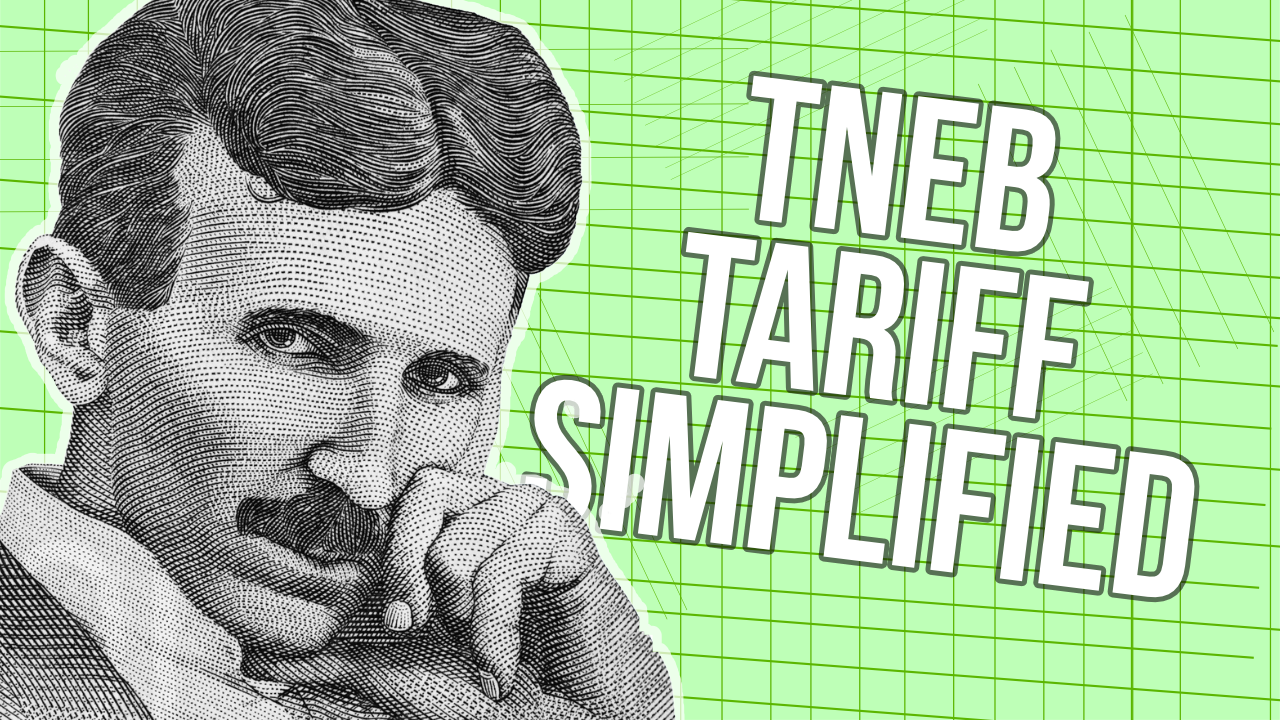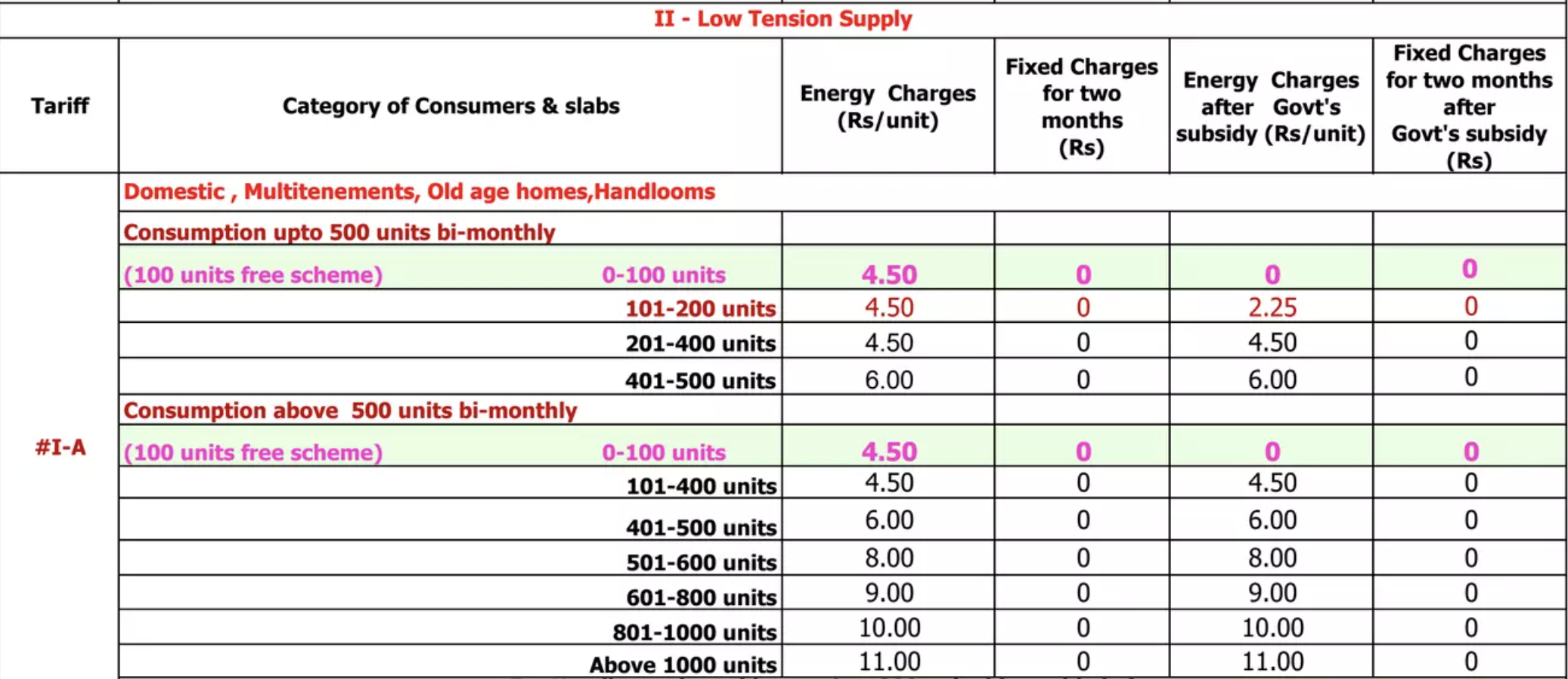- Published on
TN Electric Board Simplified Tariff ( Domestic ) & calculator
- Authors

- Name
- Akash Milton
- @mil10akash

Powered by sponsor_name is something we are all familiar with. Usually this is a figurative message the content is not literally powered by the sponsor. But when I say that this blog is “powered by TNEB'', I mean it literally and not figuratively — it’s TNEB’s power that runs my laptop, powers the modem, and lets me write this blog.
We don’t know or have to care about the pricing options because we really don’t have any options. Electricity bills aren’t telecom plans with multiple providers who try to sell you the higher plans. Electricity has one default provider TNEB with one billing model for all domestic users: use as much as you want and pay once every two months.
The pricing is tier-based, so you pay for what you use. I believe this incentivizes people to save energy, especially since this pricing is also subsidized by the government.
But this pricing is not really transparent for someone who is looking at it for the first time. There are certain issues with understanding the billing, and here’s my take.
Issues with TNEB Pricing Page
Credit where credit is due, TNEB has a bill calculator which shows the different kinds of charges and subsidies applied. However, it doesn’t give anything useful about your consumption and how it is mapped.
First, format:
There is a tariff but sadly, it is a PDF. PDF’s are great and I have a huge respect for the format but it really lacks responsiveness. It’s difficult to zoom and pan to read on a mobile device. Instead, they could have embedded the table on their website, with an option to download a PDF.
Second, too many cooks:
There are three major factors that decide the pricing:
- How much you use your Connection,
- The pricing slabs of TNEB,
- Subsidies from the Government
This creates confusion for the common public since these factors are independent of each other. For example, the costs are collected by one organization in the government while the subsidies are offered by the State Government.
You have to do a bunch of mathematical gymnastics before you figure out how you fit into the different slabs in the different bands and where the government subsidies apply, what fixed charges exist and so on.
It is easy for us to criticize TNEB for not having a better pricing page but it’s probably a side mission that works with minimum viability and everything on top of it, is nice to have.
Their main mission is to wire the whole state, balance the demand and supply, and ensure safety . Even for a side mission, they are offering the most convenient options available:online payments were available a decade ago, and UPI is also integrated today. Soon they will have UPI auto-pay and you'll be just notified.
Actual Pricing Is Hard

There are two tiers and based on your total consumption your total units will get slabbed and charged accordingly. Unlike other tiered models (such as income tax) the tiered pricing won't apply only for the unit in that range, but instead all units are charged based on the highest slab your usage is in.
For example, the units from 101-200 are billed differently for a connection with a total 400 units and connection with 600 units.
This is where people get frustrated and decide to pay whatever the bill says.
Simplified Pricing.
As a consumer all I care about is my consumption and how much I am charged, and how I can reduce that. So instead of doing the tiers, slabs, price per unit I tried a Bill amount vs Unit consumed graph. This gives a better understanding about the differences in slabs. It is a lossy simplification which means I have made some approximations and left out some values that are negligible or don't contribute in any practical use cases.
| Amount (Rs) | Units(Kwh) | Cost of last Unit(Rs.) |
|---|---|---|
| Free | 100 | - |
| < 225 | 200 | 2.25 |
| < 1125 | 400 | 4.5 |
| < 1725 | 500 | 6.0 |
| < 2750 | 600 | 8.0 |
| < 4550 | 800 | 9.0 |
| < 6550 | 1000 | 10.0 |
| > 6550 | ∞ | 11.0 |
The first 100 units are free for all tiers.
The cost per unit columns convey your savings for every unit on your bill (assuming you won’t save that much getting down the tier).
You can see a cliff between 500 and 501 with difference of Rs.233 which makes the 501st unit the most expensive unit. Previously in old pricing it was Rs.630 and people around this would have seen around 50% unpredictable jumps in pricing.
Is the TNEB fare fair?
Anyone can write a blog or website and can fix the issue with the way the pricing is presented but what about the pricing itself. Is that fair? Free plan is great and people under this limit don't even have to pay that fixed charge which makes things easy for everyone.
Tier based pricing works out for two obvious reasons:
- It offers subsidies to those who can’t afford
- It incentivizes people to use less.
Though the intention is appreciable the implementation can be better. These cliffs are unpredictable and they could follow a more granular approach where each additional unit costs a little extra than the previous one. I'm sure it is not hard to draw one.
How much is a Unit?
1 Unit is 1 kWh (kiloWattHour) .
Energy = Power(kW) X Time(h)
Let’s see a quick comparison:
Consider the 10W LED bulb that runs for 8 hours for 60 days. It consumes
10 W x 8hr/day x 60 days=> 4800Wh => 4.8 Kwh = 4.8 Units
LED IS GREAT. USE LED
Now consider the 1kW air conditioner, about 100 times the energy usage of the bulb. Running that for 8 hours for 60 days will bring it to 480 Kwh = 480 Units
Generally equipment that involves cooling or heating takes a lot of electricity. Motor appliances also consume a lot. Lights, Sounds consume negligible amounts.
| Range | equipments |
|---|---|
| 10 - 30W | LED's, Speaker |
| 40 - 60W | Fan, Fridge |
| 500W | Washing Machine |
| 100W+ | AC, Water Heater |
These days, most appliances are stickered with details about their electricity consumption.
How to save:
Most appliances that we use for a long time are low powered and vice versa and one exception to this is AC. Though AC helps in inducing sleep, it doesn't help keep you in sleep and it goes useless. Experiment with a timer and find out how long you really need AC.
Not always you have to save energy to save your bill. You can even divert some of your power usage to renewable sources like solar panels.
Comparing Old vs New Pricing
TNEB pricing has been changed 6 months later this blog was released. I have updated the pricing. I think it will be interesting to do a comparison between the old one vs the current one.